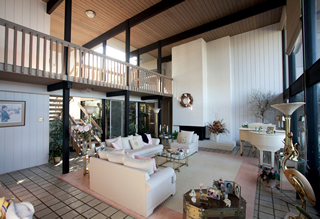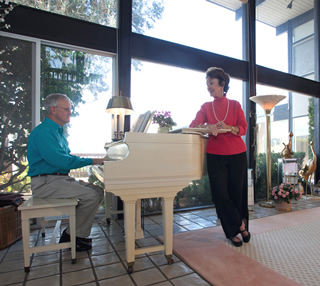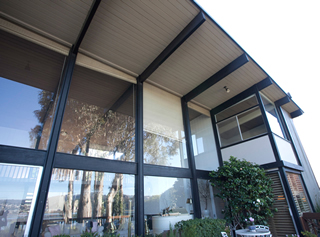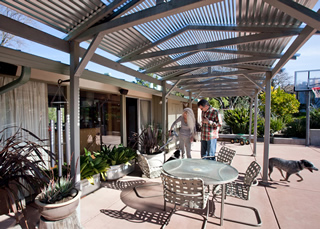Two with a View - Page 4
 |
|
|
 |
|
|
Still, despite the architects’ concern for privacy, some two-story Eichlers do provide their owners with views into the backyards and living areas of their single-story neighbors.
The Fialers can see into their neighbor’s home from their master bedroom, though they say they don’t look. “That’s our bedroom,” Sue says, “so it’s not like our living room is looking into their house.”
“The people next door put in a screen of trees,” Phil says. “It’s really very private. You can be outside and not be seen.”
And Ann Everingham has recently gained an unwanted perspective into the home of her downhill neighbor when a newcomer to that house removed a plastic awning that had provided privacy in the past.
Other downhill neighbors use landscaping to achieve the same end.
“We don’t see into anybody’s houses,” Julia Smetana says, and Ted Bloyd adds: “All we see are roofs. We can see when one of our neighbors gets a new roof.” He notes that Terra Linda today has zoning to prevent any new second stories.
 |
|
|
 |
|
|
 |
|
|
|
|
The 15 Eichlers at Strawberry Point, the first leg of a small, unfinished tract Eichler Homes launched in 1965 and 1966 as Harbor Point, make up one of the developer’s more unusual neighborhoods, in part because they were high-end homes and almost custom.
“Joe wanted each house to be different because they were priced at the high end. I guess he felt that buyers of houses in that price range didn’t want to feel they were buying a tract house,” Imada said.
“All the homes are right on the water,” Toole says. “That makes it truly a unique Eichler neighborhood.”
Her neighbors Gail and Ronald Miller, who’ve lived in their Eichler since 1988, enjoy a dramatic view of Richardson Bay through a double-height wall of glass. Their home, which appears to be a single-story from the street, steps down the hillside to the rear.
From the entry, which looks down into their atrium-like front courtyard, visitors can head up a few stairs, where the children’s bedrooms and an office can be found; or downstairs, which houses the double-height living area, double-height fireplace, and a master bedroom with another wall of glass.
“When people come in,” Gail says, “they don’t know whether to go up or down.”
An interior bridge provides a view into the living area below, where Ronald Miller’s piano can be spotted. An anesthesiologist whose book, Miller’s Anesthesia, is a standard, he helped pay his way through medical school by pounding on the keys.
The house, which received an addition to the rear for a dining room and new kitchen, has a large deck and grounds, and a tennis court on a pad above the bay.
Back when the couple threw parties, Gail Miller recalls, “You could have a couple of hundred people here, and it’s not crowded.”
The Miller home, with its size and setting, may seem an anomaly among Eichlers—along with all the two-stories.
But had Eichler lived, Imada believed, two-story homes might have become a larger part of his repertoire.
“That’s quite possible,” Imada said. “Land prices kept going up and up. And to spread those costs, he would have tried to get more units on the property.
“Another factor would have been that available land would have been increasingly on steeper-sloping land, and local pressure would have frowned on massive grading to provide a large enough pad for a single-level house.
“Another pressure, which I deplore, would have been that people are wanting more and more space for more and more junk. I wonder if Joe would ever have given in to that kind of pressure.”
Photos: David Toerge, Ernie Braun, Leo Maginnis, Art Ribbel, Barry Brisco; and courtesy Maginnis family.




